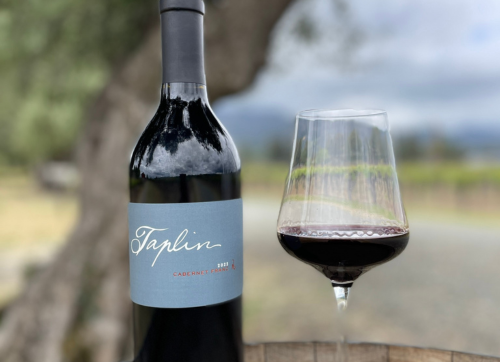Napa Valley vs French Cabernet Franc: What’s the difference, really?
Cabernet Franc, the elegant and peppery red grape long revered in France’s Loire Valley and Bordeaux, is planting some major roots in a second home these days – Napa Valley. At Taplin we are thrilled to have debuted a Cabernet Franc with the 2019 vintage, and love seeing all of the acclaim that it is getting from our fans, but we find that many people ask us – what’s the difference between Cabernet Franc that you find here in Napa and across the Atlantic?
Climate: Sun-Drenched Boldness vs. Cool-Climate Restraint
One of the most immediate differences between Napa Valley and French Cabernet Franc lies in the climate. Napa’s warmer growing conditions give Cabernet Franc a riper, fuller-bodied profile. The sunshine coaxes out richer fruit flavors—ripe blackberry, dark cherry, plum—and softens the green pepper edge that’s so characteristic of cooler-climate Franc. The result is often a rounder, juicier, and more fruit-forward wine with smoother tannins.
In France—particularly the Loire Valley—the grape ripens in cooler conditions, which preserves its bright acidity, light-to-medium body, and signature herbaceous notes. Think red currants, bell pepper, crushed gravel, and violets.
Winemaking Style: Freedom to Experiment
Napa winemakers are less bound by convention than their French counterparts. You’ll find single-varietal Cabernet Francs aged in new oak, giving them a lush, toasty richness. Others may employ natural winemaking techniques, extended maceration, or whole-cluster fermentation to craft distinctive, small-lot wines that express both creativity and terroir.
French winemakers, especially in the Loire, tend to lean into tradition. Stainless steel or neutral oak aging is common to preserve the grape’s delicate structure and freshness. In Bordeaux, where Cab Franc often plays a supporting role in blends, the focus is on structure, age-worthiness, and balance.
Terroir & Soil: Different Foundations, Different Results
California’s terroir varies widely—from the volcanic soils here in Napa to the sandy loam of south of us in Santa Barbara County. These diverse soil types, paired with a more forgiving climate, allow for a broader stylistic range. Some vineyards produce elegant, Loire-inspired wines, while others lean into lush, almost Cab Sauvignon-like depth. At Taplin, our Cabernet Franc is of the lusher variety, showcasing the complexity of our estate vineyards.
In the Loire, Cabernet Franc thrives in limestone and tuffeau soils, which lend the wines minerality and finesse. These soils naturally keep yields low and acidity high, reinforcing that lean, structured style.
The Takeaway: Same Grape, Different Soul
Napa Valley Cabernet Franc brings some of the signature characteristics of the French style, while offering its own interpretation: sun-drenched, expressive, and bold, yet still capable of delivering the complexity and savory character that make Cab Franc so beloved. Whether you prefer the earthy austerity of Chinon or the velvety richness of a Napa Valley bottling, exploring Cabernet Franc from both worlds is a delicious lesson in how place and perspective shape a wine.
At Taplin, our 2022 Cabernet Franc showcases the bold, savory side of the varietal with luxurious ripeness and intriguing aromatic complexity. Explore membership in our Signature Circle to learn more and acquire the most recent vintage.
Back to Recent Updates

